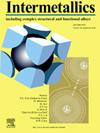Effect of vanadium content on microstructure, mechanical properties, and oxidation behavior of novel high temperature complex alloy
IF 4.3
2区 材料科学
Q2 CHEMISTRY, PHYSICAL
引用次数: 0
Abstract
Introducing vanadium (V) in high temperature alloys reduces density and increases its high temperature strength. However, the effect of V on the high temperature oxidation behavior is debatable and hence unclear. In line with that, here we developed Co30Ni45-xVxCr15Fe5Si5 (at. %) (x = 5, 10, 15, 20, 25, 30) high temperature complex alloys (HT-CAs) (all elements in at. %.) with varying V content and studied its effect on microstructure, mechanical properties and high temperature oxidation behavior (for prolonged exposure of 96 h at 1050 °C) systematically. Microstructural evolution as a function of V content shows a steady transition from single phase f.c.c. structure to multi-phase structure beyond 15 at. % with good compressive formability (ε > 50 %) whereas oxide layer thickness displayed an exponential rise beyond 10 at. % of V with a gradual increase in weight gain upon oxidation. The increased layer thickness (>350 μm) and weight gain (>45 mg/cm2) after oxidation beyond 10 at. % V in these alloys is attributed to the increased V content in the oxide layer suggesting its higher reactivity with oxygen during high temperature exposure. Thus, higher V in the HT-CAs could be detrimental from mechanical properties and oxidation resistance perspectives, hence its content needs to be tailored to minimize the oxidation losses and maximize the component life during service.

在高温合金中加入钒(V)可以降低密度,提高高温强度。然而,钒对高温氧化行为的影响还存在争议,因此尚不明确。为此,我们开发了不同钒含量的 Co30Ni45-xVxCr15Fe5Si5 (at. %) (x = 5, 10, 15, 20, 25, 30) 高温复合合金 (HT-CAs)(所有元素均为 at. %),并系统研究了其对微观结构、机械性能和高温氧化行为(在 1050 °C 下长时间暴露 96 小时)的影响。微观结构演变与 V 含量的函数关系表明,当 V 含量超过 15%时,微观结构从单相 f.c.c. 结构稳定地过渡到多相结构,并具有良好的抗压成形性(ε > 50%),而当 V 含量超过 10%时,氧化层厚度呈指数上升,氧化时重量增加逐渐增加。这些合金的氧化层厚度(350 μm)和增重(45 mg/cm2)在超过 10 % V 值后增加,这是因为氧化层中的 V 值含量增加,表明其在高温暴露期间与氧气的反应性更高。因此,从机械性能和抗氧化性的角度来看,HT-CAs 中较高的 V 可能是有害的,因此需要对其含量进行调整,以尽量减少氧化损失,最大限度地延长部件的使用寿命。
本文章由计算机程序翻译,如有差异,请以英文原文为准。
求助全文
约1分钟内获得全文
求助全文
来源期刊

Intermetallics
工程技术-材料科学:综合
CiteScore
7.80
自引率
9.10%
发文量
291
审稿时长
37 days
期刊介绍:
This journal is a platform for publishing innovative research and overviews for advancing our understanding of the structure, property, and functionality of complex metallic alloys, including intermetallics, metallic glasses, and high entropy alloys.
The journal reports the science and engineering of metallic materials in the following aspects:
Theories and experiments which address the relationship between property and structure in all length scales.
Physical modeling and numerical simulations which provide a comprehensive understanding of experimental observations.
Stimulated methodologies to characterize the structure and chemistry of materials that correlate the properties.
Technological applications resulting from the understanding of property-structure relationship in materials.
Novel and cutting-edge results warranting rapid communication.
The journal also publishes special issues on selected topics and overviews by invitation only.
 求助内容:
求助内容: 应助结果提醒方式:
应助结果提醒方式:


